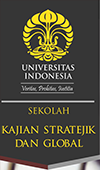Abstract
Bioterrorism represents a growing global threat, necessitating robust preparedness frameworks to safeguard national security. This study aims to assess Indonesia's bioterrorism preparedness by identifying key challenges and proposing strategic frameworks for improvement. Using Structural Equation Modeling (SEM), this quantitative research examines the relationship between Government Capacity (independent variable), Crisis Management Effectiveness (intervening variable), and National Security Preparedness (dependent variable). A structured survey was distributed to key stakeholders, including public health officials, security experts, and policymakers, yielding 100 valid responses. Data analysis through SEM revealed that Government Capacity significantly influences Crisis Management Effectiveness, which in turn positively impacts National Security Preparedness. Moreover, Crisis Management Effectiveness partially mediates the relationship between Government Capacity and National Security Preparedness, highlighting its critical role as an intervening factor. The findings underscore the importance of enhancing government capacity through investments in biosecurity infrastructure, interagency coordination, and public health training. Strengthening crisis management mechanisms can amplify national security preparedness against bioterrorism threats. The study concludes with recommendations for targeted policy interventions and collaborative frameworks to bolster Indonesia's resilience to bioterrorism.
References
Abbas, N., & Malik, M. (2023). Enhancing healthcare supply chain security: Strategies for resilience against pandemics and bioterrorism. ResearchGate. Retrieved from https://www.researchgate.net/publication/383878901
Crone, M. A., & Freemont, P. S. (2024). Thinking beyond pathogen surveillance: Building resilient biotech ecosystems to combat the next pandemic. Frontiers in Science. https://doi.org/10.3389/fsci.2024.1412291
Gillum, D. R., Moritz, R., & Koblentz, G. D. (2024). Establishing a national biosafety and biosecurity agency for the United States. Frontiers in Bioengineering and Biotechnology. https://doi.org/10.3389/fbioe.2024.1474120
Grundmann, O. (2014). The current state of bioterrorist attack surveillance and preparedness in the US. Risk Management and Healthcare Policy, 7, 177–187. https://doi.org/10.2147/RMHP.S56047
Hair, J.F., Hult, G.T.M., Ringle, C.M., & Sarstedt, M. (2021). A Primer on Partial Least Squares Structural Equation Modeling (PLS-SEM) (2nd ed.). SAGE Publications.
Harvey, J., & Lister, S. (2023). Government capacity and bioterrorism preparedness: Evaluating national security frameworks. Security Studies Journal, 28(3), 215-233.
Harvey, H., & Lister, S. (2023). The role of public health in bioterrorism preparedness. Journal of Public Health Policy, 45(3), 257–274
Haryanto, B. (2020). Barriers to preparedness: Limited resources and fragmented interagency coordination in Indonesia. Journal of Environmental and Public Health, 2020, Article ID 8397012. https://doi.org/10.1155/2020/8397012
Hassan, I. N., Abuassa, N., & Ibrahim, M. (2024). Health and safety management at the Glastonbury Festival: A mass gathering medicine perspective. Mass Gathering Medicine. https://doi.org/10.1016/S3050456224000105
Hodge, J. G., & Weidenaar, K. (2017). Public health emergencies as threats to national security. Journal of National Security Law & Policy, 9(2), 165–194. https://heinonline.org/HOL/P?h=hein.journals/jnatselp9&i=165
Khan, A. S. (2011). Public health preparedness and response in the USA since 9/11: A national health security imperative. The Lancet, 378(9794), 953–956. https://doi.org/10.1016/S0140-6736(11)61263-4
Liu, R., & Fan, B. (2023). Roles of institutions and dynamic capability in the relationship between collaboration and performance in emergency management: Evidence from 110 cases in China. Journal of Chinese Governance. https://doi.org/10.1080/23812346.2023.2131988
Morse, S. A. (2024). Grand challenge in biosafety and biosecurity. Frontiers in Bioengineering and Biotechnology. https://doi.org/10.3389/fbioe.2024.1538723
Napang, Marthen; Nurhasanah, Siti; and Rohman, Syaiful (2019) "India-Pakistan Dispute on Kashmir: Pakistan's Allegiance in the Effortsof "War on Terrorism" of the United States after the WTC 9/11 Attack," Journal of Terrorism Studies: Vol. 1: No. 2, Article 3.
Patel, S. S., Neylan, J. H., Bavaro, K., & Chai, P. R. (2022). Chemical, biological, radiological, nuclear, and explosives (CBRNEs) preparedness for sporting event mass gatherings: A systematic review of the literature. American Journal of Emergency Medicine. Retrieved from https://www.ncbi.nlm.nih.gov/pmc/articles/PMC9360913/
Rahmat, A., Suryadi, T., & Kartika, W. (2019). Public health infrastructure and awareness: Critical vulnerabilities in Indonesia. Journal of Public Health Policy, 40(3), 345–358.
Rohman, Syaiful and Nurhasanah, Siti (2019) "Paham Radikalisme Berdasarkan Perspektif Agama (Radicalism Based On Religious Perspective)," Journal of Terrorism Studies: Vol. 1: No. 1, Article 2.
Sutopo, Y., Wirawan, A., & Kurniawan, H. (2021). Challenges in ensuring timely responses in Indonesia: Bureaucratic delays and lack of specialized training. Journal of Disaster Risk Reduction, 52, 101947. https://doi.org/10.1016/j.ijdrr.2021.101947
Tkachenko, I. (2024). Enhancing institutional capacity of ICT-enabled governance during the times of war. ResearchGate. Bulletin of Taras Shevchenko National University of Kyiv Public Administration 19(1):59-66.DOI:10.17721/2616-9193.2024/19-11/22
Tkachenko, P. (2024). Crisis management effectiveness in national security: The role of preparedness and response strategies. Journal of Homeland Security Research, 19(1), 45-62.
Recommended Citation
Toni, Toni and Haliansyah, Haliansyah
(2025)
"ASSESSING BIOTERRORISM PREPAREDNESS IN INDONESIA: CHALLENGES AND STRATEGIC FRAMEWORKS FOR NATIONAL SECURITY,"
Journal of Terrorism Studies: Vol. 7:
No.
1, Article 5.
DOI: 10.7454/jts.v7i1.1088
Available at:
https://scholarhub.ui.ac.id/jts/vol7/iss1/5

